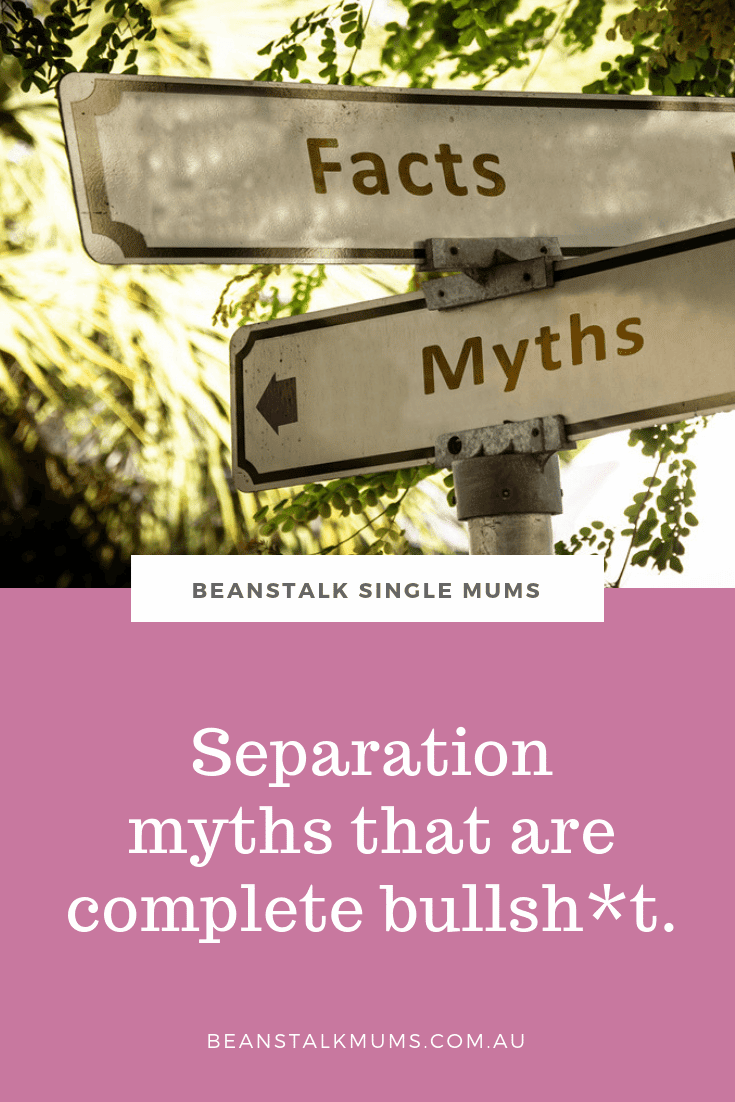
Let’s talk about separation myths.
Separating from a long term partner can turn your world upside down. Beyond the day-to-day reality of simply surviving through the shock, coping on your own and then having to somehow explain it all to the kids, you also have to tackle all the annoying financial and legal stuff that you’d rather just bury in the sand (probably along with your head!).
On top of that, you’ll be flooded with questionably ‘helpful’ advice from family and friends about what their experiences were. This includes what Aunty Betty did when she divorced her husband in the early 90s and what they’ve seen on Facebook.
They might mean well and some of their advice will undoubtedly come in handy, but when it comes to the legal and financial matters (including property division), family and friends just aren’t the most accurate source of information.
HERE ARE SOME OF THE SEPARATION MYTHS YOU MIGHT HEAR
They might tell you separation myths such as:
- Everything is split 50/50
- You’ve been together for a year, so you’re entitled to half
- You didn’t have the house in your name? Uh oh! or
- Don’t worry – you’re the woman/wife, so you’ll get the most!
It can be scary when you don’t know the truth. And it’s daunting trying to find accurate information, especially when so many urban myths surround the subject of separation and property division. Let’s clear up a few of these separation myths now.
SEPARATION MYTHS WE SUGGEST YOU IGNORE
MYTH #1: EVERYTHING IS SPLIT 50/50
The truth is, there’s no pre-determined ratio of property division in family law. In fact, there’s not even a clever mathematical formula the legal people use to determine this! Every situation is unique and the Family Law Act outlines a number of factors that influences each individual decision.
On the surface, a 50/50 split might seem like a fair option, but there are so many different types of relationships. You might be in a relationship where:
- both people work full time
- one half is a stay-at-home parent
- one person is self-employed, and the other works part time and parents the rest of the time
The combinations are almost limitless, which is why property settlement is decided based on the parties’ respective contributions over the course of the relationship.
MYTH #2: IF YOU’VE BEEN IN A RELATIONSHIP FOR MORE THAN 12 MONTHS, YOU’RE CONSIDERED ‘MARRIED’
A very common separation myth is that if you’ve been with your partner for a year, you’re automatically considered a de facto couple with the same legal status as a married couple. This is not true. Nor is it true that you must be in a relationship with your partner for a full 12 months to be considered a de facto. For a relationship to be classed as de facto, you are required to be living in a ‘marriage-like’ state and this is determined on an individual basis.
For example, you’re not considered de facto if you’ve been living with a person for two years but you are not living as though you’re in a relationship (neither sleeping together nor sharing finances). You may be considered in a de facto relationship if you’ve been living with your partner for only 6 months, but you’ve known each other for much longer, have a child together, have a ‘marriage-like’ relationship and share all assets and finances.
For defacto relationships, either party has the right to apply to the court for property orders after they’ve been together for two years. It doesn’t mean they will get anything it just means they have the right to apply. Bear in mind that applying to the court is time consuming and expensive – it is not something that you would do on whim.
MYTH #3: THE ASSETS YOU OWNED (INCLUDING A BUSINESS) BEFORE YOU BEGAN YOUR RELATIONSHIP WON’T BE SPLIT
The assets you own (including a business) prior to the relationship should be examined before they are divided, based on a ‘just and equitable’ basis according to the Family Law Act. This analysis will determine which assets will be included in the ‘net asset pool’ that is to be divided.
We show the steps, below, but to put it simply, you can look at the contributions made by each person during the relationship and use this to determine how the assets will be divided.
For instance, if you had assets or a business prior to the relationship, and these assets weren’t mingled as part of the relationship and/or your partner did not contribute to the growth of these assets, the law may consider these to be a separate asset pool, which will not be split in the same way as the rest.
MYTH #4: YOUR BUSINESS WAS SOLELY YOURS, SO YOUR EX HAS NO CLAIM TO IT
Unfortunately, this may not be true. Like the above answer, the overall contribution of each person will be considered before dividing anything up. The division of a business and its assets after a separation can be complicated with many different outcomes, so we recommend you seek legal advice.
MYTH #5: YOUR PARTNER WAS ABUSIVE OR UNFAITHFUL, SO YOU’RE ENTITLED TO MORE
Even though you might feel like moral consequences should matter, when a Court is determining each person’s contribution to the relationship, divorce and property law in Australia completely disregards the reasons for why a relationship ended. It seems totally unfair, but this keeps the law fair for all.
MYTH #6: YOUR INTERESTS IN A COMPANY/PARTNERSHIP/TRUST ARE NOT RELEVANT IN THE PROPERTY SETTLEMENT
This is not true and often comes as a shock to those who try to hide assets by registering them to a company or trust name!
MYTH #7: YOU DON’T NEED TO DISCLOSE PERSONAL ASSETS, SUCH AS PRIVATE SAVINGS, SUPERANNUATION OR OTHER ASSETS IN YOUR NAME ONLY
As mentioned, you really shouldn’t hide asset, earnings or other interests from your partner, lawyer, or the Court. You and your ex partner have a legal ‘duty of disclosure’ about your finances pertaining to the timeframe you were in the relationship, as well as just before and after. This means you must tell each other about any earnings, income, loans, property, interest, superannuation or other financial matters you may have or related to you, no matter what name you’ve put them under.
MYTH #8: THE TITLE DEEDS TO THE HOUSE ARE IN YOUR PARTNER’S NAME, SO THAT MEANS YOU’RE NOT ENTITLED TO ANYTHING
Just like all other assets, a property in the name of either party is considered a shared asset of the marriage/relationship, which means it will be included in the asset pool mentioned below.
MYTH #9: YOU STAYED AT HOME WITH THE KIDS AND DIDN’T WORK DURING THE MARRIAGE, THEREFORE YOU’RE NOT ENTITLED TO ANY OF THE ASSETS
When the Law determines your contribution to the relationship, they usually value the role of a stay-at-home parent as being equal to that of the working parent. Australian law sees both roles as contributing substantially and significantly to the relationship, so a parent will never be penalised for this.
MYTH #10: YOU CAN’T DIVIDE SUPERANNUATION
Superannuation is considered ‘property’ but it is treated differently to other assets. For example, Super can be divided or “split” (except in Western Australia) but you cannot access the funds until you retire.
MYTH #11: YOU BOTH NEED TO SIGN THE ‘DIVORCE PAPERS’
Thankfully, this is a myth perpetuated by US TV shows. In Australia, you’re able to lodge a divorce application without the consent of the other person.
MYTH #12: PROPERTY SETTLEMENTS COST THOUSANDS!
Yes, they usually do – unless you’re smart and take some of the power into your own hands by using a Financial Agreement kit.
MYTH #13: YOU NEED TO GO TO COURT TO GET A PROPERTY SETTLEMENT
As you may have guessed, this is also not true. Only a very small proportion of people (about 5%) end up going to Court for a relationship breakdown. The rest are agreed upon via personal negotiations or other mediation, even if they aren’t all amicable.
Once the parties have agreed on division of assets, the parties can formalise their arrangement privately by using a Financial Agreement or they can apply for Consent Orders. Application for Consent Orders need to be put through to the Court for review and approval, but that’s an easy step that’s not the same thing as ‘going to Court’.
BUSTING THE SEPARATION MYTHS
As you can see, most of the things you hear about separation are simply myth. The fact is, there is no set formula that you can use to divide assets and liabilities following separation. Every property division is unique and based on the individual circumstances of each situation.
It sounds highly complicated but don’t despair. The Family Law Act does give us some guidance and a list of factors to consider when deciding how to divide assets and liabilities. These considerations fall under the two main categories of ‘contributions’ (referring to the overall contribution each person makes to the relationship) and ‘future needs’ (the ongoing needs each person will have after a separation, like the ongoing care of children for instance).
Negotiating and finalising a property settlement is comprised of the following steps:
- Identifying the property pool
- Considering the ‘contributions’ of the parties
- Considering the ‘future needs’ of the parties
- Formalising your agreement
For more information on this process, please visit RP Emery’s comprehensive article to learn more.
As mentioned, this may all seem complicated, but we can make it so much simpler for you. If you’d like to explore how to document your property settlement, peacefully, without spending a fortune in legal fees, contact RP Emery Legal Kits on 1800 608 088 today.














